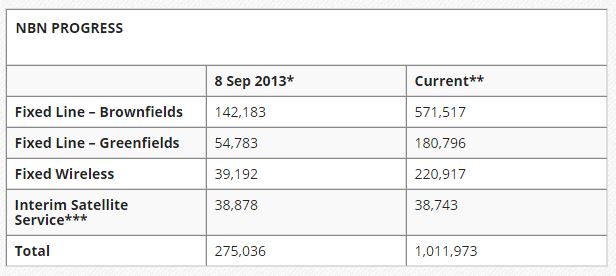
Communication Minister Malcolm Turnbull has announced a major milestone in the NBN construction. Australia’s NBN is now available to 1 Million premises. This number is a large jump from the 607,915 premises passed and marked ready for service on May 21st, around 3 weeks ago. The number was 270,036 at the last election.
Such a jump can only be attributed in large part to the Satellite and fixed wireless services that enable large parts of the population to be switched on quickly. This obviously comes at the cost of congestion during peak times and the speed possible on these types of connections are far less than that of direct fibre to the node or the best option, fibre to the premises.
During the press conference, it was revealed that 200,000 premises are now either using or ready for service using fixed wireless services. Turnbull also said the average wait time for a household to get connected to the NBN is around a month, although many people online are suggesting the wait can be much longer.
In terms of the breakdown of connection types, Fixed Line is highest with 571,517 serviceable premises using this method which is largely made up of FTTN. Next is Fixed Wireless connections, with 220,917 serviceable premises using this technology. Next is Fixed Line – Green fields, this should be all FTTP as new estates are required to install fibre rather than copper. The last is an interim satellite service which supports 38,743 premises.


If you’re connected to the NBN on any of these technologies, please run a speed test and post the link or photo in the comments.
While 1 Million homes and businesses are now capable of getting an NBN service, we don’t yet know how many have taken up the opportunity. With speeds on the multi-mix technology version of the NBN being incrementally better than current offerings (or in some cases worse than ADSL2+) it’s not surprising not everyone is getting on-board. It was often thought that the prospect of getting your front lawn dug up and holes drilled through your walls for installation were key barriers to acceptance, but now it seems the value proposition isn’t making sense for a lot of households.
With still around 9 Million premises still to go it’s unlikely the NBN will achieve it’s 2016 targets and everyone by the 2019/2020 deadline. The promise of delivering the NBN ‘sooner and cheaper’ has been the argument for the technology change. Announcing you’ve reached 1 Million premises is an easier task when you can add a satellite or wireless base station that broadcast to thousands of homes at once. Basically you’re cheating your way to the number.
No longer can we compare the rollout numbers of the two very different NBN models, of course you can roll out one faster than the other, but the devil is in the detail. Like manufacturing, cheaper and faster isn’t always better, in the long run this will come back to bit Australia as these quick and dirty solutions to increasing broadband speeds will need to be upgraded again.
Basically it boils down to this.. even when the rollout of the coalition’s NBN is “complete” the job won’t be done. Our needs by 2020 will certainly outstrip the capabilities being created now. Those on FTTP will have gigabit plus speeds, while those on other technologies will be left with a congested 25Mbps. To solve this, expect tax payers to have to put their hand in their pockets again for upgrades to towers and satellites.
The announcement that the NBN has reached 1 Million premises is an important step forward for Australia’s biggest infrastructure project, but the road ahead is a long one. Just remember, the rest of the world isn’t standing still.
More information at the Minister’s website.
Image credit: Paul Fletcher on Twitter.
